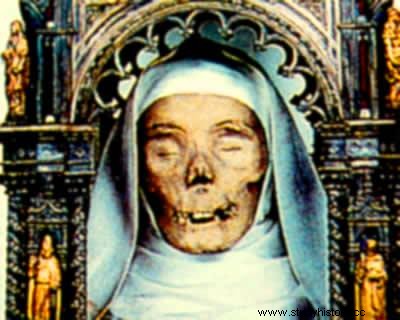
By Rainer Sousa
During the Middle Ages, the expansion of Christianity was responsible for the development of various faith experiences. At the beginning of this time, the account of the devotion of several Christians inspired the religious conversion of people who took such stories as proof of Christian truth. More than just an admirable narrative, such stories provided a way of proceeding to the faithful and determined the appearance of the first martyrs and saints of this religion.
Parallel to the force of these accounts, the objects and body parts of these sanctified Christians became the object of fervent veneration. Such relics functioned as the great material proof of all the suffering and abnegation of the characters that figured in the Christian universe. Over time, such sacred objects attracted thousands of pilgrims who, touched by the appreciation of a sacred item, made donations to the Church's coffers.
From a religious point of view, contact (even if visual) with the sacred relic meant the guarantee of the attainment of a grace or the spiritual protection of a lifetime. For churches and cities, possession of a relic operated as an element of protection and good fortune. In addition, the pilgrimage of the devotees meant the collection of large collections and the development of local commerce. Undoubtedly, an experience of economic growth accompanied such acts of faith.
Over time, the search for relics came to organize worship rituals that could be considered quite bizarre today. In the 14th century, for example, a reliquary containing a small amount of Saint Januário's blood began to liquefy from time to time. The transformation of this blood, originally preserved in a solid state, drew the attention of several devout pilgrims to this ancient sanctity of the fourth century.
In the mid-1260s, the tomb housing Saint Anthony of Padua was opened more than thirty years after his death. Upon examining the saint's remains, it was found that his tongue remained practically intact. Seen as proof of her immaculate life, her tongue was removed from her body and can still be seen today in the Basilica of Saint Anthony of Padua, Italy.
In 1083, a group of clerics ordered that the body of St. Stephen of Hungary be dug up so that his beatification process could begin. Once again, when observing the general condition of the body, they noticed that his hand was in perfect condition. The hand was promptly extracted to become the most important relic of St. Stephen's Basilica, located in the city of Budapest.
In the 14th century, the death of Saint Catherine of Siena provoked a dark dispute over possession of her body. The solution found was to extract his right foot, which ended up in the city of Venice, and his head, which remained as the main relic of his hometown. Currently, the rest of his body is deposited in the city of Rome, capital of Italy.
If these cases are already peculiar, we must not stop talking about the relics related to the life of Jesus Christ. The search for objects that appear in his biblical biography opened doors for the emergence of the same relic in several European cities. The blood of Christ, the famous shroud and foreskin of the Messiah are some of the objects of worship and dispute that figure in this story.
For the most critical, these situations would historically prove that Church members used various stratagems to capture the attention and resources of their faithful. From a historical point of view, we consider that the relics marked a religious experience peculiar to medieval times, exposing the various places that the sacred can occupy in the life of societies over time.
